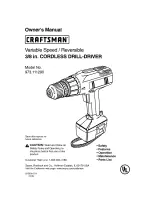
13
WARNING:
Have you read
“POWER TOOL SAFETY”,
“SPECIFIC SAFETY RULES”,
“BATTERY & CHARGER SAFETY”
and “SYMBOLS” on pages 3, 4, 5, 6,
7 & 8 of this Manual? If not, please
do so now before you operate this
saw. Your safety depends on it!
Every time you use the saw you
should verify the following:
1. Blade is in good condition
2. Blade is firmly clamped in the
blade holder
3. Proper eye and hearing
protection are being worn.
Failure to adhere to these safety
rules can greatly increase the
chances of injury.
MATERIALS YOU CAN CUT
This reciprocating saw is a versatile tool
that allows you to cut many different types
of materials. Some of the materials include:
●
Wood products such as lumber,
hardwood, plywood, composition
board and panelling
●
Drywall
●
Masonite and plastic
●
Metals such as pipe, steel rods, sheet
steel, aluminum, brass and copper.
NOTE:
There are many different types of
blades available. Generally, there are metal
cutting blades (fine teeth) and wood cutting
blades (coarser teeth). Use the correct
blade for your application. The packaging
on the blade will indicate the type of
materials each blade is designed to cut.
GENERAL CUTTING
1. Clearly mark the workpiece to locate
the position of the cut.
2. Hold smaller workpiece with a vice.
Clamp larger workpiece to a work
bench or table.
DANGER:
Any workpiece that
is not adequately clamped in place
may come loose and cause serious
injury. Never hold the workpiece
with your hand(s).
3. Make sure there are no nails, screws,
clamps or foreign materials in the path
of the saw blade.
4. Hold the saw away from your body and
in front of you (Fig. 5).
5. With both hands firmly gripping the
saw, and the blade NOT in contact
with the surface to be cut, start the
saw by depressing the lock-off button
and squeezing the trigger switch.
6. Once the saw has reached the desired
speed, place the adjustable pivoting
shoe against the workpiece and
gradually bring the moving blade into
contact with the workpiece at the
appropriate location.
CAUTION:
Do not force the saw.
Use only enough force to keep the blade
cutting. Excessive pressure on the
blade will cause it to bend and twist,
which may result in breaking the blade.
!
!
OPERATION
!
Fig. 5





































